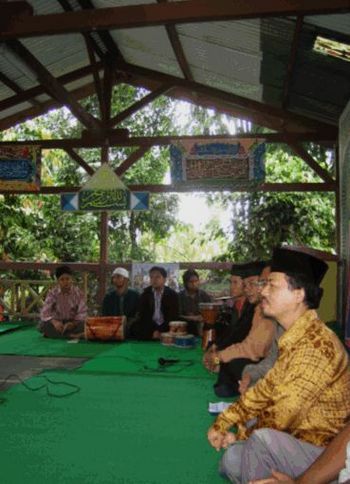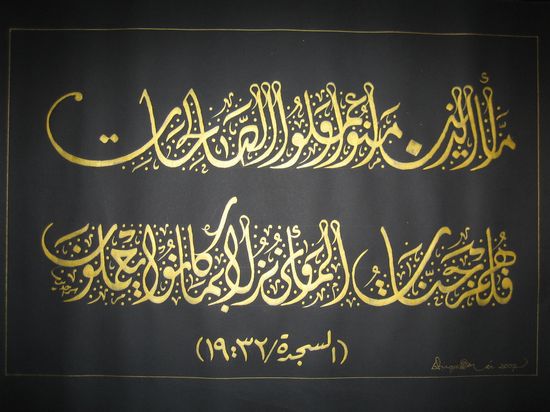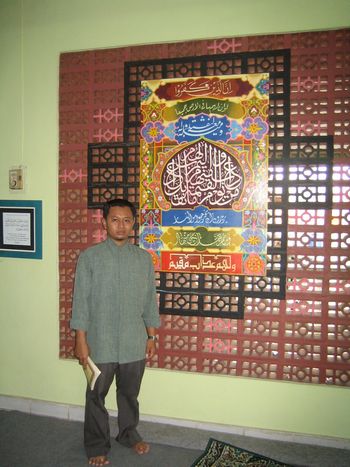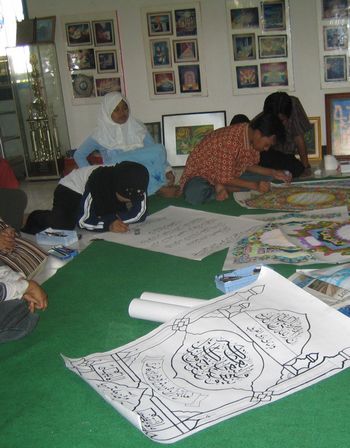Virginia Hooker
Students at the calligraphy pesantren practise for a competition.Copies of Pak Didin’s paintings hang on the back wallVirginia Hooker |
Concentrating intensely, a group of young Muslims guide their pens to form the flowing Arabic letters which spell out the verses of the holy Qur’an. They are talented artists who have come from across the Indonesian archipelago to study with Didin Sirojuddin, one of Indonesia’s leading calligraphers and to devote themselves to mastering the complex rules of Islamic calligraphy.
‘Writing for Allah’ is both an act of devotion and a peaceful and positive expression of Islam. The first letter of the Arabic alphabet, the upright single stroke called ‘alif,’ is believed to have been created by a divine pen activated by mystical light. The students studying with Pak Didin, as he is known, use a range of different sizes of styluses made from wood imported from Saudi Arabia for classical calligraphy. The sizes and proportions of each letter are based on a strict code of geometric rules devised by the 10th century master, Ibn Muqla. The size of the dot made by the point of the stylus is used as the basic measure to calculate the height and width of each letter.
Pak Didin’s students follow the ancient rules of calligraphy. But they are firmly planted in the here and now. They do modern calligraphy using felt pens. And when they need to double-check the wording or spelling of a Qur’anic verse they borrow an iPhone to log in to a Qur’an website, locate the verse, and check their copy against it. Modern technology makes its contribution to the accurate rendering of God’s sacred words.
A unique pesantren
Indonesia has thousands of pesantren, Islamic schools and colleges, which teach the Islamic sciences, including Arabic calligraphy. But Pak Didin’s pesantren is the only one which is devoted entirely to the study and practice of calligraphy. Although he has taught calligraphy both in Jakarta and in a number of provinces since the 1980s, he believed only the establishment of a special centre dedicated to advanced accredited courses would produce a new generation of professional calligraphers.
It was a painstaking process, beginning in 1996, to garner support from religious leaders, identify a suitable location, and raise funding to buy land and build a pesantren. In August 1998 the first students were enrolled at the Pesantren for Qur’anic Calligraphy. At present it is a modest group of buildings located on the outskirts of West Java’s beautiful hill resort of Sukabumi, although Pak Didin hopes to expand. The buildings feature open-air pavilions surrounded by trees and overlooking terraced rice fields, misty mountains, and fast-running streams. Pak Didin encourages his students to take their materials out into the beautiful surroundings so that their work can be inspired by the natural beauty and reflect God’s power of creation.
 |
Pak Didin (first right) entertains visitors to the calligraphy pesantren,with marawis ensemble waiting to play.Virginia Hooker |
Didin admires the civilisation of ancient Greece because it valued and loved knowledge. It continues to inspire him, especially Socratic philosophy. ‘Socrates was very close to God and would hold dialogues with members of society – I do that too,’ explains Didin. Socrates would walk through Athens asking questions of those he passed so that he could try to help them. Didin practises the same philosophy with his students. He also applies it at national calligraphy competitions which bring together Indonesian calligraphers from all over the archipelago. Beginning in 1988 he started asking the participants what they felt they needed to develop Indonesian calligraphy and what the obstacles were. Their replies became a stimulus for his work.
The 120 students who enrol annually for the full-time, two semester, diploma course at the pesantren study classical and contemporary styles of calligraphy. They also study Qur’anic interpretation and Islamic civilisation, marketing and entrepreneurship, social service and preparation for calligraphy competitions. There are regular visits to galleries, museums and exhibitions, and meetings with established calligraphers. The pesantren also encourages music and the marawis (drum) ensemble of young men often accompanies groups of young women who sing kasidah, or religious songs, set to lively tunes with subtle, beautiful rhythms. A part-time, intensive course is offered at Pak Didin’s Jakarta base in Ciputat which is well-attended every weekend. Children can learn the basics of calligraphy at a kindergarten run by his wife at the Sukabumi pesantren or in special school holiday courses. Pak Didin has published many books on calligraphy, including sets of graded texts for his students.
Pak Didin’s staff are as dedicated as he is and all teach for minimal pay. This means that even the poorest of students - if they have talent and commitment - can enrol for courses. Pak Didin stresses that all his staff are appointed on merit. He does not follow the old tradition of pesantrens dominated by one religious teacher whose relatives and family hold key positions in the pesantren. He says that the calligraphy pesantren belongs to all who use it.
From comics to calligraphy
Born near Kuningan in West Java in 1957, Pak Didin was always drawing. Between 1969 and 1975 he attended the famous Pondok Moderen Gontor in East Java and began his formal study of calligraphy. He continued his studies at the State Islamic Institute (now University) Syarif Hidayatullah in Jakarta, where he has long been a lecturer. One of his hobbies was illustrating comic books and his talent was recognised by Hamka’s son, Rusydi. He was so impressed that he invited the young Didin to become a reporter with the magazine Panji Masyarakat, where he worked during the 1980s. This was also the period he was making his name as winner of national and international calligraphic competitions.
Pak Didin is acknowledged as one of Indonesia’s best practitioners of classical calligraphy. He is also well-known for his calligraphic paintings in which ‘classical’ calligraphy is combined with abstract art, featuring icon-like representations. These works have been shown in many public exhibitions and purchased by collectors. Even in his abstract art calligraphy, we can see Pak Didin’s interest in social issues. But it is in his designs for calendars that his conviction that calligraphy can serve society is most evident. Since the early 1990s, Pak Didin has been preparing calendars with each month’s picture featuring a vibrantly inscribed verse from the Qur’an. The themes differ from year to year based on the key social issue of that time. The annual themes have included corruption, justice, education for children, poverty and hunger, using Qur’anic verses appropriate to each issue. In this way, he is providing a daily reminder to his fellow Muslims of God’s words of guidance for them.
Calligraphy competitions
Pak Didin encourages his students to enter calligraphy competitions. He believes competing fosters their talent, broadens their experience and deepens their religious practice. Pak Didin was himself grand champion of the all-ASEAN calligraphy competition of 1987. He serves as a judge for Indonesian competitions and is invited to exhibit and judge in contests throughout the Middle East, in Turkey and Pakistan, as well as in Southeast Asia.
 |
Qur’anic verse in the classical ‘thuluth’ script inscribed by Didin Sirojuddin in 2007 for M B Hooker. From Chapter32:19 it reads: ‘Those who believe and do good deeds will have gardens awaiting them as their home and as areward for what they have done.’Jamie Matheson |
There were not many contestants in the early 1980s, when calligraphy had just been accepted as a serious category in the Indonesian National Qur’an Recitation Competition. Gradually, with the encouragement of masters such as Pak Didin, the numbers have grown into the hundreds. Women and men enter a range of categories, the most demanding of which lasts for seven hours. During that time contestants have to inscribe a set Qur’anic verse in seven different styles of script, and illuminate the verse with a decorated border.
Pak Didin judges at calligraphy competitions across Indonesia, from local to provincial and national levels. He takes the opportunity to use his ‘Socratic dialogue’ technique to ask judges, officials and competitors for their opinions and their needs. Based on this feedback he says, ‘Young students of calligraphy in regional areas are crying out for attention and for more intensive training.’ His pesantren at Sukabumi and his centre in Jakarta teach hundreds of students each year, but not thousands. It is Pak Didin’s dream to make specialist teaching available to more and more Indonesians across the country. Many of the graduates from his courses become teachers and return to their home villages to continue and extend his work.
Piety and beauty
Calligraphy is multi-faceted in its effects on Muslims. Those who actually write the letters experience a direct relationship with the sacred words of revelation as each letter is inscribed and placed on a surface. They perform an act of devotion as they re-create and give substance to the words of the Qur’an. Viewers of a completed work of calligraphy, whether it be placed on a wall, a calendar, a plate, or even a headband, may or may not be able to understand the meaning of the Arabic words. Even if they do not understand the message from Allah, they are able to appreciate the visual effect of the beauty of the letters as a work of art.
 |
H.M. Dhohiruddin from Jambi, former student and now staff member ofthe calligraphy pesantren, who has won numerous calligraphy contests.From Qur’an Chapter 5:36, his decorative piece hangs in the mosqueattached to Pak Didin’s home in JakartaVirginia Hooker |
The harmony between the dimensions of each letter, their relationship to each other, and the pleasing symmetry each calligraphic phrase presents to viewers, is symbolic of the perfection of Allah and His essential oneness. It serves as a reminder of Allah’s power and omnipotence in all spheres of creation. It invites the viewer to reflect, if only briefly, on the spiritual aspects of being. As Panji Masyarakat noted, for Pak Didin ‘calligraphy is not only about aesthetics it also about metaphysics’.
Recognising the grace and benefits that contact with calligraphy brings, Indonesian Muslims purchase objects decorated with Qur’anic calligraphy to display in their mosques, offices and homes. As the Muslim middle class strengthens, its members increasingly dedicate part of their income to pious acts. And more and more members of this new middle class are deciding to spend money on learning calligraphy. If they have insufficient talent or time to devote to classes, they buy calligraphic works, even if these are calendars and wall hangings.
Graduates from the certificate course at the unique calligraphy pesantren are conscious of the spiritual benefits their calligraphic practice brings. They are also increasingly confident that they can make a livelihood selling serious and not so serious works of calligraphic art. Many also say they want to continue Pak Didin’s work of teaching calligraphy to those young Indonesians who are ‘crying out for attention and for more intensive training.’ As a result of Pak Didin’s work, his graduates are ensuring that calligraphy, the noblest of the Islamic arts, remains a living tradition. Not confined to museums or art galleries their writing for Allah is within reach of almost all Indonesian Muslims.
Virginia Hooker (Virginia.Hooker@anu.edu.au) is a Visiting Fellow in the Department of Political and Social Change, College of Asia and the Pacific, The Australian National University. She would like to thank Bapak and Ibu Sirojuddin for their hospitality and patience and Ismatu Ropi MA who introduced the author to them. Pak Didin very kindly gave the author permission to photograph and re-produce his work here.
